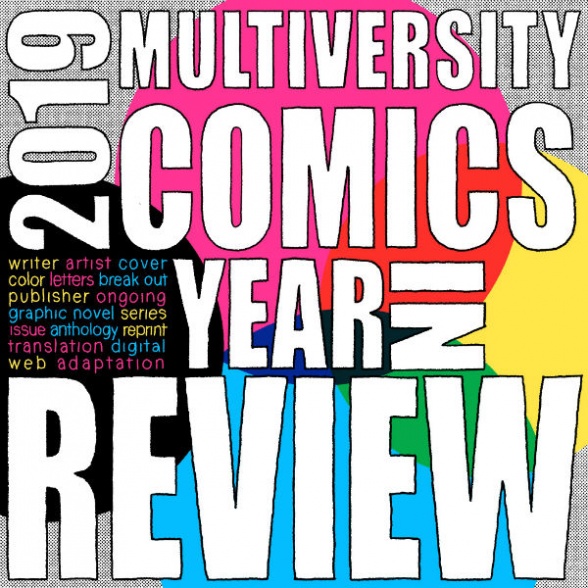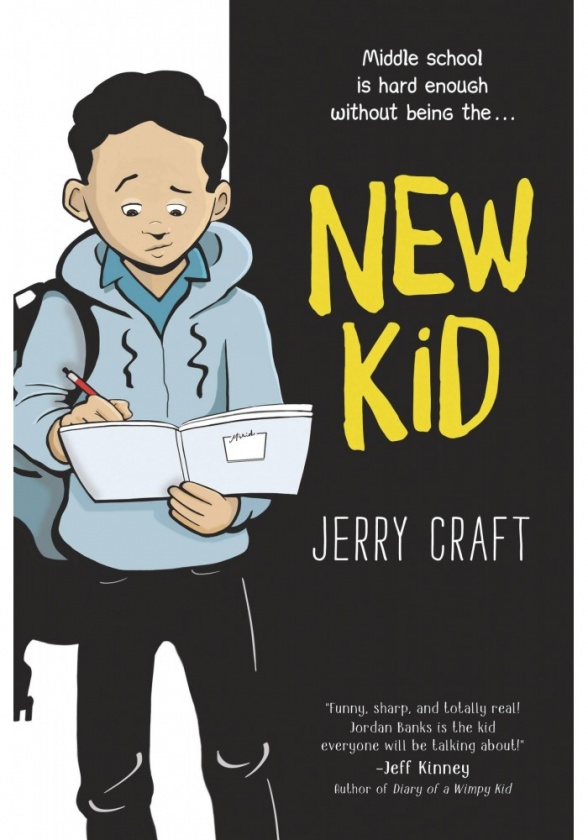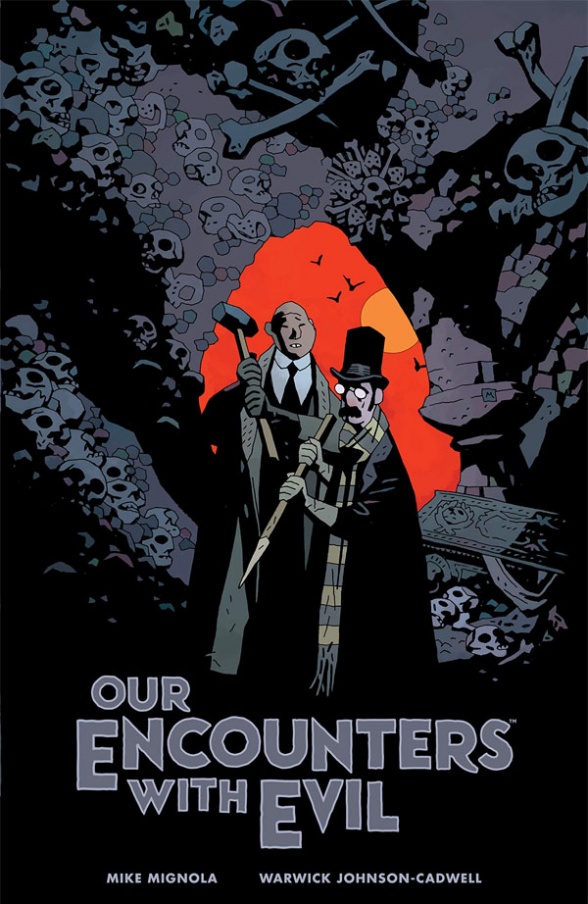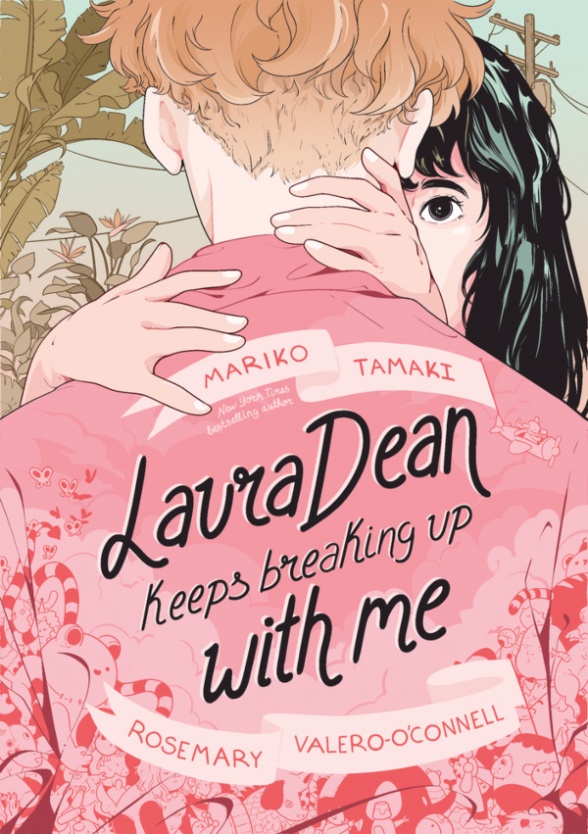
It is always a good feeling when someone looks over our list for a given category and complements it. Two of our staffers did just that when they saw this list of graphic novels. I agree; it’s a diverse list from a very diverse year of comics.

10. New Kid
Middle school is a time of discovering, growing, and realizing the world isn’t quite what we were taught it was as a child. Most middle-graphic novels use that as a basis, but few use it as incisively as Jerry Craft does in “New Kid.” As seventh-grader Jordan Banks learns when he starts attending a private school in an upper-class white area, classism and racism are often sneaky devils in modern American culture.
As with all slice-of-life middle-grade graphic novels, the story focuses on Jordan’s day-to-day issues like adjusting to school life and dealing with shifting friendships. The central concept, however, allows Craft to explore how race and class distinctions are everywhere. When Jordan first arrives in class, he can feel everyone’s eyes shift to him and the one other black student in the class when the teacher mentions “financial aid.” Jordan feels conflicted about whether he should befriend the few black kids in school even if they have nothing in common. A teacher at the book fair recommends a black student a “gritty tale of survival” about a black man in poverty without a father, while offering the white student next to him a fantasy adventure novel. Even the hyper-aware soccer coach ends up weirding Jordan out with his constant attempts to apologize: “What are you, an eskimo?” is immediately followed by, “Is that racist? I’m sorry if anyone found that offensive.”
On the art side, Craft clearly comes from a comic strip background where the individual figures are more important than the backgrounds, yet while there’s often a lack of cohesion between the two, this focus on character expressions typically enhances the story. Craft is also unafraid to get goofy when he wants, at one point depicting Jordan as an infant when his parents fight, or drawing the father’s hand as giant when depicting his overly-intense handshake.
The story posits that in the end, while the overall culture is still problematic, if Jordan’s new friends are willing to acknowledge and avoid these racist and classist attitudes — as well as all forms of separation and distinction — then they can help each other build a better future. And that ending keeps things hopeful not just for the target audience, but everyone reading. – Nick Palmieri

9. Are You Listening?
It should come as no surprise that Tillie Walden’s “Are You Listening?” has made our list. Her past two books, one an OGN, the other a reprinted webcomic, were both featured in 2017 and 2018 respectively.
“Are You Listening?” is a book about unlikely friends, the driving need to escape one’s past, and a cat. It is a book of great focus and depth, with humor in the unlikeliest of places and dread from all too real fears. While the book is not twist heavy, I feel that saying too much about it can ruin the journey, because that’s what Tillie has perfectly captured in her new book, the intimacy of a road trip, especially one where it is only the origin, and not the destination, that mattered.
It is a book firmly in the magical realist genre, showing once again that Walden’s storytelling prowess is expansive and diverse while retaining the core of her success, that of her deeply human characters.
I should also note that, while it is brief, the book does deal with the subject of sexual assault, a fact made clear in the blurb. I say this here because in “Are You Listening?,” Walden approaches the topic, and its presentation, with care and precision, not shying away from it nor allowing it to be voyeuristic or sensational or, in actuality, depicted. Instead, it is presented in an artistically sensitive, impressionistic manner that uses magical realism to invoke the moment, overlaid with narration. It is a striking moment that refuses to traffic in the salacious and for that, this book is worth the read.
Continued belowThis, among other reasons, though, makes it a more challenging book than her previous two. Smaller in scope, and far more dramatic by virtue of being constructed rather than memoir, the book asks its readers to read into the darkness, to hold dual, triple possibilities in their minds and to work their way past the thorns to the roses. Yet, throughout it all, there is the peaceful sound of wheels on the road and wind through the doors and the empty expanse of the Texan wilderness.
We are alone with these two, and they are alone with each other, allowing that deep experience and knowledge of another that can only be found when the walls are worn away by the winds of travel and exhaustion. – Elias Rosner

8. The Adventure Zone: Murder on the Rockport Limited!
The Adventure Zone is a wildly popular podcast where four family members, a father and three sons, play role playing games together, which weave together into multi-layered stories that are equal parts funny and fantastical. Translating that into a comic isn’t exactly easy. And yet, Clint McElroy and Carey Pietsch have done just that with aplomb, and the second in the series, “Murder on the Rockport Limited,” sees the pair even more comfortable with what the adaptation should look like and accomplish.
While certain bits just don’t work on paper, the guts of the story translate surprisingly well, and Pietsch does a yeoman’s job in finding visual styles for characters that, until now, have only existed in the minds (and fan art) of listeners. None of her designs seem to be wildly off-base from what was described on the show, and she manages to imbue them all with a certain look that instantly fits into the world she created.
But the storytelling is the star here, with Pietsch and McElroy distilling down a dozen or so hours of play into a relatively concise comic, and not losing much along the way. As the series continues, I look forward to how they continue to pare down and refine the story into these thoroughly enjoyable comics. – Brian Salvatore

7. Dreamers of the Day
“Dreamers of the Day” is a graphic memoir by Beth Barnett documenting her research trip to the U.K. for a firsthand look at T.E. Lawrence’s life and personal effects at Oxford. Barnett digs into the archives to uncover more about the iconic man’s life (he’s the Lawrence of Arabia Lawrence, for reference) and in doing so provides a nuanced and tender glimpse into the past, as well as her future as a maker of comics.
“Dreamers of the Day” succeeds because it captures that quicksilver quality of good memoir. There’s no one detail or page that punches us in the gut. Rather, the progression of a life examined and the joys and tensions of research on a timeline make the book sing. Barnett has said that she gravitates to people who live or experience the world in ways she also wishes to live. “Dreamers of the Day” initiates us into the life of someone many of us might have left back at the crossroads of history, and Barnett weaves these details into her own journey with borderless panels, crisp lines and a flowing, easy style that makes excellent use of negative space and the page turn.
Barnett has further plans for Lawrence, and this first foray promises more quality to come. “Dreamers of the Day” will draw you in with curiosity and leave you both emotionally and intellectually sated. What a delight! – Christa Harader

6 (tie). Pumpkinheads
Set over just a few hours, “Pumpkinheads” follows Deja and Josiah’s exploits on their final evening at the pumpkin patch before leaving for college. With two hundred pages to explore such a small space of time, the comic immediately feels very intimate. This is a book where the little moments matter. Writer Rainbow Rowell and illustrator Faith Erin Hicks invest so much into the details of “Pumpkinheads” that it holds up at close scrutiny too. And it had to, because as much fun as the book is the first time around, the second read through is better.
Continued belowPlus, it’s just fun spending time with Deja and Josie. As I said, this is a book about small moments and “Pumpkinheads” makes those small moments count. There’s a cumulative effect at play so that you reach the end of the book feeling nostalgic about a place you’ve never been to and people you’ve never met. – Mark Tweedale
6 (tie). They Called Us Enemy

The words “required reading” strike fear in the heart of many a child, because required reading in school was more of a chore than anything. Let’s be honest: very few of us wanted to read Great Expectations or The Great Gatsby in high school. (Though I freely admit to liking the latter.)
There are some books, however, that really should be required reading for children and adults alike. “They Called Us Enemy” is one of them.
What makes it important is that this story — George Takei’s tale of growing up in American concentration camps during World War II — is that it is happening again. History is repeating itself at the American southern border, and — regardless of what you may think about United States immigration policy — images of children being ripped from their parents, living without even the most basic of comforts, dying of diseases as common as the flu, are no way for a child to live.
The combination of classic manga style and a script that emphasizes Takei’s innocence at what to him is an adventure, but to his parents is a frightening uncertain future and a betrayal by their country underscores the bleak gravity of the family’s situation. And while it taught Takei resilience and hope, along with coloring his pursuits of social justice, it is frankly no way for a child to live. While “They Called Us Enemy” treads mainly in memoir, important historical facts and figures are peppered throughout to provide a sobering and uncomfortable history lesson, particularly in the final third of the book as Takei draws the parallels between his childhood experiences and current events. Artist Harmony Becker also knows when to dial down the fun and joy of manga and dial up strong, forceful pencils and inks — and you see that on some of our most revered public figures. If you’re squirming at the site of beloved Franklin Delano Roosevelt drawn as a harsh villain, much like Thanos, you should be. We may remember FDR as the architect of the New Deal who sang “Tomorrow” with Annie Warbucks, but for Takei and millions of innocent Japanese-Americans, he essentially Thanos-snapped them out of their American existence.
I would love to see a copy of “They Called Us Enemy” on every legislator’s desk. It’s a necessary wakeup call to the events of 75 years ago repeating themselves, in more barbaric, brutal, and inhuman ways that ever before. – Kate Kosturski

5. The Hard Tomorrow
When my kid is grown and wants to know what I felt like around these years, these years frighteningly pivotal to our planetary future in these harrowing political times, I’m going to give her “The Hard Tomorrow.”
Eleanor Davis comics are always deceptively potent, hanging around your memory as simple lines that somehow explain your soul, the way good folk music or a trusty bike trail might. But that chemistry reached whole new levels this year with “The Hard Tomorrow,” as I, and the many other graphic novel readers of my age and inclinations, found in Davis’ fictional near-future story from Drawn and Quarterly of a woman fighting for a better future and trying to create life with a man she loves.
The book responds with gentle wisdom to a question so many of us ask. If tomorrow is so dreadful, so dreadful that we must take to the streets demanding change, so dreadful that our only hope is a radically different world, so dreadful that some would bunker down and prepare for the impending apocalypse… then why would anyone want to bring new life into it?
I’ll give my kid this powerful graphic novel, one I’ll probably indelibly remember more than any other this year, and tell her that the answer is in the last few pages of this book. Yet the wise sentiments those evoke would mean nothing without the hard journey Davis takes us on to get there. – Paul Lai
Continued below
4. Our Encounters with Evil
This isn’t a book that had to exist. “Mr. Higgins Comes Home” could’ve easily been the last we’d seen of Professor Meinhardt and Mr. Knox and that would’ve been perfectly fine. However, Warwick Johnson-Cadwell clearly loved the world and characters he and Mike Mignola had created. There was an energy in his “Mr. Higgins Comes Home” work that simply would not be contained to a single book and it exploded out into “Our Encounters with Evil.” It’s this energy that makes this sequel feel vital. Of course there’s more! How could there not be?
Johnson-Cadwell uses “Our Encounters with Evil” to open up the world, giving himself and Mignola a bigger canvas to play with not just for this batch of short stories, but for future stories too. And “play” is the keyword here. This doesn’t feel like calculated growth; rather it’s sheer joy in discovery and invention. Johnson-Cadwell seems to delight in every detail on the page, to the point that even something as simple as an establishing panel can feel uniquely suited to this comic series.
And that delight is infectious too. I finished the book immediately impatient for the next. If there’s anything “Our Encounters with Evil” makes clear, it’s that there simply must be more Meinhardt and Knox. – Mark Tweedale

3. Bloom
Have you ever read the “Hannah Swenson” prose novels? They’re a series of murder mysteries but every other chapter has an actual recipe in it. Now, imagine that but instead of a murder mystery, it’s a romance coming of age story and there’s, like, one recipe but the whole thing is super cute and emotional and gay and in a limited color palette that brings a coolness to the warmth of this story about baking and relationships and the messiness of navigating a world that wants to impose a path before you’ve even gotten the chance to see another.
Got all that? Well, congrats! You’ve got a rough approximation of “Bloom” by Kevin Panetta and Savanna Ganucheau. It’s a book with a lot of heart in all the right places while also perfectly capturing that whiny teenage attitude that (most) everyone has, even when they don’t realize it. Seriously, the focal character Ari is the worstTM when we begin and, were it not for the deft pens of Panetta and Ganucheau, his attitude would have dragged the story down rather than making it the tense and engrossing narrative journey we got.
Romance is a genre that is under-served and undervalued in the world at large, especially queer romance stories, despite it being the genre that speaks the most to our own lives, dominated in the minds eye as either erotic-adjacent paperbacks or juvenile fantasies. Rare are the titles that break out of the quagmire of that misconception, thought that is changing, especially in the YA field. As such, it is heartening to see books such as “Bloom” or “Laura Dean Keeps Breaking Up with Me” become such hits and make it to lists such as these. They are important and meaningful and “Bloom” makes certain that for teens coming across this story, it will speak to their current struggles while older folks will remember what it was like to feel that way and, hopefully, empathize with a plight (hopefully) long past them.
There is more to it, of course, but that would be spoilers and where’s the fun in that? Half the enjoyment of a romance book is the struggle, the will they/won’t they, and the final resolution that either ends with a kiss or something a bit more bittersweet. – Elias Rosner

2. Frogcatchers
At first glance, “Frogcatchers” looks suspiciously like a bot-generated Jeff Lemire work, cherrypicking elements from his past comics and mixing them together into something ‘new.’ But once you get a few pages into the book, it reveals itself in such a lovely, slow way, and it becomes clear that this is an altogether new creation.
A brief meditation on death, regret, and acceptance, this book see Lemire pare down his normal style to just the basic elements. Like Mike Mignola’s later work, “Frogcatchers” appears to be stripped off all unnecessary details, instead focusing on the storytelling first and foremost. The sketchier, uncolored style both reflects back to Lemire’s earliest work and also points forward to a newly refocused palette.
Continued belowThe final pages of the book are among the most moving and beautiful in any comic I’ve read in a very long time, and the emotions feel earned and justified, even though we have been introduced to these characters in a very limited way. We know little of motivations, or opinions, or even personalities. We are simply seeing the story of a person and, specifically, the end of a person’s life. It is a story that is universal, that is simple, and is emotionally resonate. I can’t imagine anyone not being choked up at the end of this book. – Brian Salvatore

1. Laura Dean Keeps Breaking Up with Me
“Laura Dean Keeps Breaking Up with Me” is one of those great pieces of queer lit that manages to look beyond the circumstances of sexuality and truly focuses in on the personal dynamics within a relationship. I think the most impressive thing about the book is that it feels authentic. I mean, the whole novel is framed around how toxic Laura Dean is for Freddy, but it still manages to portray her as entrancing and irresistible to Freddy. The novel shows you why Freddy keeps coming back to someone who toys with her emotions.
Rosemary Valero-O’Connell captures emotion and pace perfectly, giving a sense of involvement in each scene which lends the writing sincerity and authenticity. Furthermore Valero-O’Connell perfects the monochrome/pastel color palette she used in “What is Left;” allowing it to direct the reader’s eye between panels and contexts masterfully.
Mariko Tamaki’s writing measures up to the high bar Valero-O’Connell sets. The relationships she writes aren’t soap operatic, they’re teenage, which is almost as ridiculous, but they feel believable and full of human foibles. “Laura Dean” follows a new trend of modernist queer lit set in an optimistic America where LGBTQIA+ adversity has, largely, been overcome. It’s a piece where the obstacles in front of the protagonist don’t stem from her sexuality but from her individual affections. It’s romantic fiction with autonomy, looking at the necessity of love and the price it demands.
You end up reading the book and relating it back to yourself because the story is so intrinsically unique that it becomes universally relatable. This is partially achieved by how Tamaki focuses on the “after happily ever after” aspect of the story; a lot of people will have a good story about how they met a significant other, but everyone has a story about how they lost theirs. However, “Laura Dean Keeps Breaking Up with Me” moves beyond the simple break up story by showing readers not only how to move beyond the raw emotion of losing someone they love, but also how to regain autonomy, reclaim the neglected aspects of their life and willingly grow into a more fully formed being.
I love “Laura Dean Keeps Breaking Up with Me” because it is such a human story that’s written in a medium filled with the super-human. Mariko Tamaki and Rosemary Valero-O’Connell created a gem that defines graphic novels in 2019 and I’m so happy it’s getting the praise it deserves. – James Dowling






